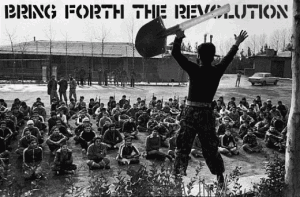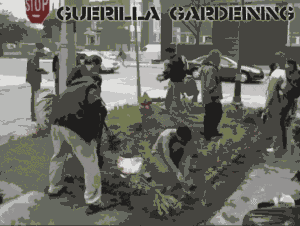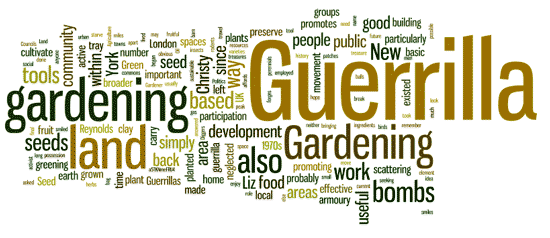“Was the earth made to preserve a few covetous, proud men to live at ease, and for them to bag and barn up the treasures of the Earth from others, that these may beg or starve in a fruitful land; or was it made to preserve all her children?” Gerrard Winstanley The New Law of Righteousness, 1649
Although Guerrilla Gardening within the modern context has existed since the 1970s when Liz Christy a New York based activist coined the name ‘The Green Guerrillas ‘when she and her friends took over a piece of derelict land in the Bowery Houston area of New York and began to cultivate fruit, vegetables and herbs, guerrilla gardening has probably existed in history since the development of what we know as Agriculture.
What is Guerrilla Gardening?
In practice Guerrilla gardening is the cultivation of neglected and unused pieces of land within, and around our towns and Cities, the land on which people usually carry out this form of gardening on is owned by Councils, statutory departments, and some is under private ownership. To sum Guerrilla Gardening up in a nutshell I would say that it is groups of people who cultivate plants within the Public and Civic space without necessarily seeking permission.
What are the basic tools for Guerrilla Gardening?
 The Guerrilla Gardening movement has a number of basic tools which it uses to carry out its work, apart from the obvious things you will need such a good hand trowel and fork, the most well known of the tools of the guerrilla gardener are seed bombs.
The Guerrilla Gardening movement has a number of basic tools which it uses to carry out its work, apart from the obvious things you will need such a good hand trowel and fork, the most well known of the tools of the guerrilla gardener are seed bombs.
Seed bombs are a mixture of clay, compost, seeds and water; these ingredients are then mixed together, shaped into small balls and left to dry out. Seed bombs are a very effective way of greening up an area of neglected land, they can simply be thrown on the ground and left to germinate, their design also affords them protection again rodents and birds who are not able to break through the hard outer clay. Diverse varieties of seeds are also a useful accompaniment to seed bombs and are particularly good in promoting beneficial insects and pollinators. Plug plants are a very useful tool in the Guerrilla Gardeners armoury, plugs can me sown at home in a tray and then planted outside in public spaces, a plug plant is simply a young plant that has been grown in potting tray.
Fruit canes and bushes are also very useful, they can be planted quickly, and because they are perennials they will provide fruit over a long period of time. And the final tools in the Guerrilla gardener’s armoury are cheek and a sense of humour; we are planting and sowing in public spaces so we should be mindful to remember that some people will look at you with puzzlement, some with outrage and some with smiles on their faces. A few years an old Lady stopped and asked what I was doing whilst I was scattering seeds and seed bombs on the way to work, I simply answered ‘I’m scattering seeds in the hope that flowers will grow here’ she smiled and said ‘Keep up the good work’
The Politics of Gardening
 Guerrilla Gardening also has a Political element to it, since land has become a precious and expensive commodity leaving little in the way of community land Guerrilla gardeners have stepped over the public/private line by cultivating land that they neither own or in possession of like a home garden just as Liz Christy with her New York based Green Guerrillas in the 1970s. Guerrilla gardening in the UK although linked to Liz Christy in the US also goes back to the time of the Diggers and Levellers of the English Civil war and the idea that the earth and Land are common treasure for us all to enjoy. London based Guerrilla Gardener Richard Reynolds has probably done more than anyone else in promoting Guerrilla Gardening in the UK, though much of Reynolds work is based in London, his website www.guerrillagardening.org promotes events and forges links with other Guerrilla gardening groups from across the globe. Guerrilla gardening is part of the broader battle to reclaim the commons and bring back land into public use.
Guerrilla Gardening also has a Political element to it, since land has become a precious and expensive commodity leaving little in the way of community land Guerrilla gardeners have stepped over the public/private line by cultivating land that they neither own or in possession of like a home garden just as Liz Christy with her New York based Green Guerrillas in the 1970s. Guerrilla gardening in the UK although linked to Liz Christy in the US also goes back to the time of the Diggers and Levellers of the English Civil war and the idea that the earth and Land are common treasure for us all to enjoy. London based Guerrilla Gardener Richard Reynolds has probably done more than anyone else in promoting Guerrilla Gardening in the UK, though much of Reynolds work is based in London, his website www.guerrillagardening.org promotes events and forges links with other Guerrilla gardening groups from across the globe. Guerrilla gardening is part of the broader battle to reclaim the commons and bring back land into public use.
Guerrilla gardening for a permanent culture
As we move towards a possible sustainable future, Guerrilla gardening has an important role to play, particularly in the development of local food production. The current peak in a number of resources such as Oil and gas means that we can no longer rely on our food being grown thousands of miles away, Guerrilla gardening in built up urban areas could be employed to turn local vacant patches of land into fertile food growing areas. It is also and effective way of greening up heavily urbanised areas and bringing back the wildlife that previously lived in the area. Guerrilla gardening promotes civic involvement and community building through active participation, and it is this active participation and community building which is so important in the development of a broader grassroots global social movement.

